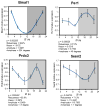Untimely oxidative stress in β-cells leads to diabetes - Role of circadian clock in β-cell function
- PMID: 29458148
- PMCID: PMC5910243
- DOI: 10.1016/j.freeradbiomed.2018.02.022
Untimely oxidative stress in β-cells leads to diabetes - Role of circadian clock in β-cell function
Abstract
Diabetes results from a loss of β-cell function. With the number of people with diabetes reaching epidemic proportions globally, understanding mechanisms that are contributing to this increasing prevalence is critical. One such factor has been circadian disruption, with shift-work, light pollution, jet-lag, increased screen time, all acting as potential contributory factors. Though circadian disruption has been epidemiologically associated with diabetes and other metabolic disorders for many decades, it is only recently that there has been a better understanding of the underlying molecular mechanisms. Experimental circadian disruption, via manipulation of environmental or genetic factors using gene-deletion mouse models, has demonstrated the importance of circadian rhythms in whole body metabolism. Genetic disruption of core clock genes, specifically in the β-cells in mice, have, now demonstrated the importance of the intrinsic β-cell clock in regulating function. Recent work has also shown the interaction of the circadian clock and enhancers in β-cells, indicating a highly integrated regulation of transcription and cellular function by the circadian clock. Disruption of either the whole body or only the β-cell clock leads to significant impairment of mitochondrial function, uncoupling, impaired vesicular transport, oxidative stress in β-cells and finally impaired glucose-stimulated insulin secretion and diabetes. In this review, we explore the role of the circadian clock in mitigating oxidative stress and preserving β-cell function.
Keywords: Bmal1; Circadian clock; Diabetes; Insulin; Islet; Nrf2; Oxidative stress; β-cell.
Copyright © 2018 Elsevier Inc. All rights reserved.
Conflict of interest statement
There are no potential conflicts of interest.
Figures



References
-
- Roglic G World Health Organization. Global Report on Diabetes. World Health Organization; Geneva, Switzerland: 2016.
-
- B.o.L. Statistics. Workers on Flexible and Shift Schedules in 2004 Summary. 2005.
-
- Karlsson BH, Knutsson AK, Lindahl BO, Alfredsson LS. Metabolic disturbances in male workers with rotating three-shift work. Results of the WOLF study. Int Arch Occup Environ Health. 2003;76(6):424–430. - PubMed
-
- Muller JE, Ludmer PL, Willich SN, Tofler GH, Aylmer G, Klangos I, Stone PH. Circadian variation in the frequency of sudden cardiac death. Circulation. 1987;75(1):131–138. - PubMed
Publication types
MeSH terms
Grants and funding
LinkOut - more resources
Full Text Sources
Other Literature Sources
Medical

